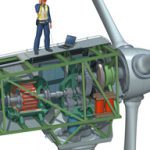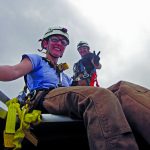The U.S. coastal environment offers challenges to widespread offshore wind development compared to projects installed in Europe. The prevalence of hurricanes along the Eastern seaboard and the Gulf of Mexico will require additional considerations as the U.S. defines its design standards. These issues are being addressed by several groups, such as a recent National Academies Transportation Research Board Committee and the AWEA Large Wind Turbine Compliance Guideline Committee.
What can be confusing is in the definition of the external design condition or reference wind speed across conflicting time averaging and reference height conventions. For instance, the design standards for wind turbines often refer to a 10-minute average, 50-year return, extreme wind speed at hub height (e.g. IEC 61400-1). Meanwhile, the Saffir-Simpson scale for hurricane intensity is based on one-minute averages, and values are referenced at a standardized 10m height. Additionally, the American Society of Civil Engineers has defined a peak-gust map (ASCE 7) for use in minimum design loads for buildings. The values on this map are also at a height of 10m, but indicate a 3s gust. In order to properly navigate the relative interpretation of time-averaged extreme wind conditions in various standards and data sources, conversion factors are needed from empirical data. A suitable wind shear model is also needed to translate the data between 10m and turbine hub height (approximately 80-100m).
Time Averaging Conversions: The following information, from the archived literature, provides a means to estimate the conversion between various time-averaging extreme wind speed conventions. Based on information from Powell et. al (Wea. Forecast. 11, p.329-349) , the Atlantic Oceanographic and Meteorological Laboratory recommend the following equation for adjusting between a 10-min. average and a one-min average wind speed:
![]()
Additionally an estimation of 3s gusts from one-min. averages can be described by Hsu (Elec. J. Struct. Eng., 8, p. 77-79) as a function of the power law exponent , α, discussed below:
![]()
The resulting equation that can be used to roughly estimate the conversion of 3s peak gust data to a 10-min. average is thus:
![]()
There are also Gust Factor curves, such as that of Durst (Meteorol.Mag., 89, 181–186), which can be used to adjust between time-averaging conventions.
Wind Shear Conversions: Most extreme wind reference values are at a height of 10m above the ground or sea surface. Therefore, in order to interpret the value of extreme wind speeds at the turbine hub height—which is often 80-100m above the surface—for use of design standards, wind shear approximations are needed. Two methods are commonly used by the wind industry to define wind shear conditions: the Power Law, and the Log Law. The Power Law is defined here for the example case of a 10m reference height:
Power Law:
![]()
Where, Vhub is the wind velocity at hub height in m/s, V10 is the wind velocity at the reference height of 10 m in m/s and hhub is the hub height in m. The parameter that defines the specific shear conditions is the exponent, α, which is often assumed as 0.11 for the offshore environment. For any wind development project there is a need for information on the 10-minute average extreme wind speed at hub height for the project site to determine suitability for wind turbine technologies in accordance with loading guidelines, such as those of the International Electrotechnical Commission (IEC) for the turbine’s type certification. For instance, the maximum classification given by these guidelines (IEC 61400-1) are for a reference extreme wind speed of 50m/s averaged over 10min at hub height with a 50-year return. As it stands, if the extreme conditions estimated for a site exceeds this reference wind speed, a turbine specially built for the situation would be needed.
It is arguable that the extreme wind speed conditions experienced in U.S. coastal waters would be during a hurricane event, so as an example of using the above correlations the IEC standards are compared here with the Saffir-Simpson Scale. Using the relationships defined above, a 50 m/s (112 mph) maximum 50-year extreme wind speed for an IEC class I turbine at 80m would correlate to a39.8 m/s (89 mph) 10min averaged wind speed at 10m, and a 44.6 m/s (100 mph) one-minute averaged wind speed at 10 m, which is a category 2 hurricane based on the Saffir- Simpson scale. This example highlights the importance of these conversions, as extreme wind conditions along the coasts may be defined with reference to hurricane intensities.


































